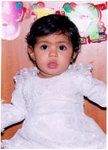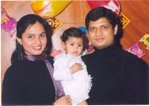Just the other day, I realized that not everyone knows much about breastfeeding.
All that "it-comes-to-you-naturally" stuff doesn't happen in real life. Also, most often your own Mums have had babies so long ago, they are not expected to remember all the details! So what ends up happening is that you get bombarded with often conflicting, well meant advice and you are more at sea than you were before!
Having gone through the process of trial and error, here are some tips I'd like to pass on.
1. Start preparing when you are pregnant.
Before the baby is born, make sure you oil your nipples well. Many people have dry skin during pregnancy and while we pay ample attention to the skin on our face and hands, your nipples need attention now. Oiling them and keeping them moisturised goes a long way in making it easier when your baby is born.
Take "Shatavari Kalp" (Ayurvedic herbal drink) with a glass of milk in the ninth month of your pregnancy. This will ensure that you have enough milk for your baby when she is born. Shatavari Kalp will be available at many chemist shops and will definitely be available in Ayurvedic shops or shops that sell herbs.
2. The First Feed.
If you've had a normal delivery, your baby will be brought to you soon after you have settled down in your room after the delivery. If you have had a Cesarean, your baby may be brought to after your anaesthesia has worn off a bit. Again, if you have been given spinal anaesthesia during your delivery, you will be advised by your doctor not to over on your side for 24 hours. In such a case, have a pillow placed by your side lengthwise and place your baby on the pillow so she can reach your breast without having to turn over. You will need to have someone watching so the baby doesn't accidentally roll off the pillow.
3. The Actual Feeding.
Ideally, your baby should have maximum skin contact with you while feeding. It helps to make the baby feel warm and secure. It goes a long way in developing the mother-baby bond. Personally, I found that touching and holding my baby while feeding her also helped me to cope better with my post-surgery pain.
- Place your baby so you are both facing each other with the baby's mouth at your breast.
- If you can, put your arm around your baby.
- Let your baby open her mouth wide and latch on to your breast. Make sure that your nipple and areola (brown portion around the nipple) are in your baby's mouth. The baby's lips should be outside her mouth and visible around your breast.
- Don't hesitate to detach your baby and go through this process again till you both get it right.
- If your baby gets only the nipple in her mouth, she will be unable to get a good enough flow of milk and will cry out of frustration. Your nipples will get very sore very soon and you will find all future feeds painful, so get it right.
- From there on, your baby will be able to suck the milk in.
- Allow her to feed from one breast for a maximum of 15 minutes by the clock and then change over to the other breast.
- Hold your breast with your fingers in a "C"shape for all this (Thumb and index finger forming a "C" around your breast.")
- If you want to detach your baby, make sure your fingers are clean and slip your little finger into the baby's mouth to break the suction and then pull your breast out.
Some Facts:
Your baby may sleep off while feeding. If you feel she hasn't had enough milk, gently rub her cheek or her ears or the back of her head to wake her. Do NOT shake your baby at all. Do NOT pat your baby.
Your baby does get tired sucking. All her mouth muscles may pain with all the hard work they go through getting milk. She may take small gaps while feeding. Allow her those gaps. Be patient.
Your baby may get a small sucking blister on her lips because of the friction between her lips and your breast initially. This will stop when she is more used to drinking milk.
Your nipples may feel very sore initially. There are many creams available that you can apply to alleviate your pain. Your doctor should be bale to help you with a prescription. If you feel too much pain or experience bleeding nipples, you could use a breast shield. The important thing is to openly communicate with your doctor about all discomfort.
Your breast milk is almost 90% water (my Doctor friend told me this). Drink at least 2 litres of fluids so you have enough milk.
If you feel you are not having enough milk for your baby, talk to your doctor. She may prescribe medicines which help in generating milk. Alternatively, you could try "Shatavari Kalp" an ayurvedic medicine. It is made of Asparagus and is miraculous in its effectiveness. There are many other options available to help lactation. Talk to your doctor about them.
As your baby grows, you will find that you have both developed an understanding of what is best for you. Do not hesitate to experiment (within reasonable limits) with different positions and grips for the two of you.
When my baby was very tiny, I preferred feeding her while sitting in a chair with armrests and holding her so her spine was along my arm and my palm was near her bottom. Slowly, this changed and now at 14 months, it is most convenient to feed her while both of us are lying down.
See what works best for you and enjoy it! Also share it with us, so some weary mother can get some help when it is her turn to feed her baby!



No comments:
Post a Comment